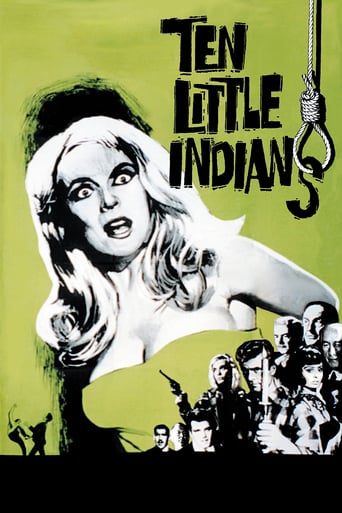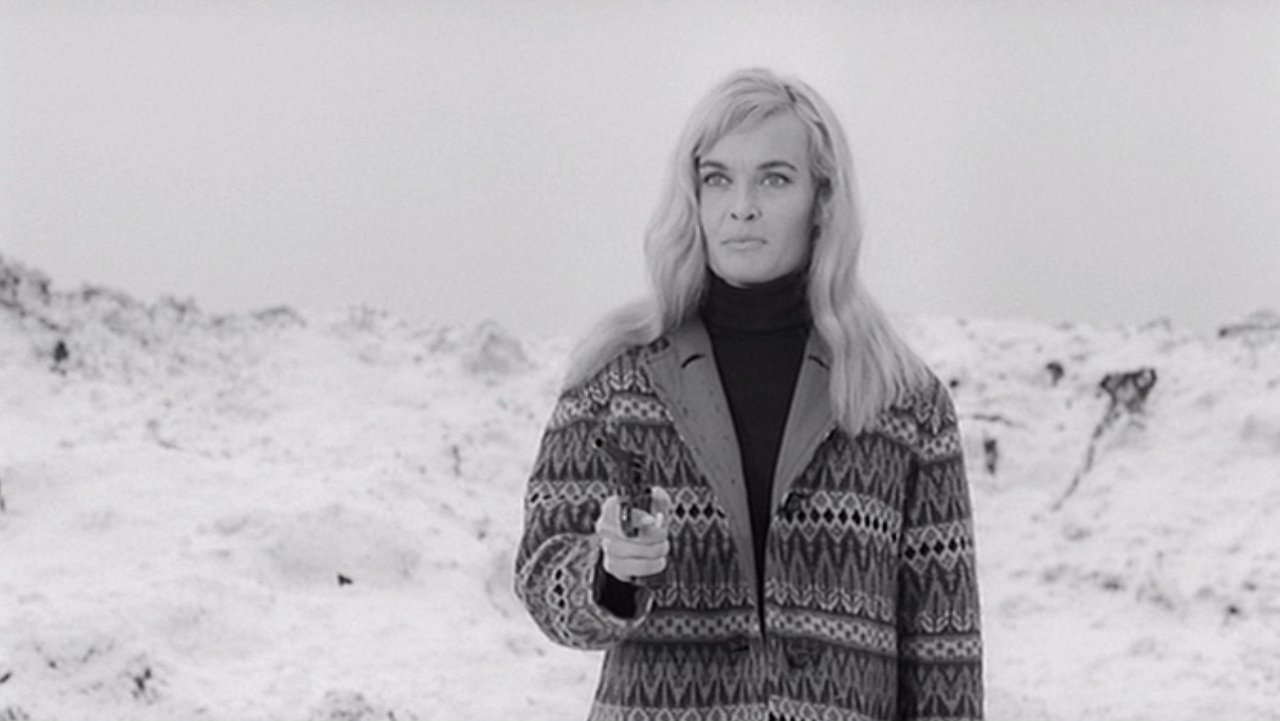Dalbert Pringle
In this fast-paced (and fairly entertaining) "whodunnit" from 1965 - The characters in this one's story are, literally, dropping like flies (left, right, and centre).Set at a remote castle atop a steep mountain cliff - (Where the game of death gets underway) - Everybody is suddenly under suspicion and the mad race to uncover the true identity of the mysterious "Mr. Owen" escalates the drama into a literal frenzy of false leads and erroneous accusations.Based on Agatha Christie's 1939, mystery novel "And Then There Were None" - "Ten Little Indians" features an all-star cast headlined by Hugh O'Brian, Shirley Eaton, and (1960's pop idol) Fabian.
zardoz-13
"10 Little Indians," the second cinematic version of Agatha Christie's timeless murder mystery "And Then There Were None," alters the setting from the 1933 film, but preserves its premise in that everything in this version occurs atop a mountain with no way of escape. Just as in Rene Clair's original version, ten people are invited to spend a weekend in the Austria Alps rather than on an island. After each of them inspects their separate but respective rooms, they observe that framed copies of "Ten Little Indians," the children's nursery rhyme, have been hung up on the walls of each bedroom. No sooner have they sat down to dine than a reel-to-reel recording plays and informs them that they all have murderous backgrounds. The enigmatic fellow who invited them has the odd name U.N. Owen, but he never shows up for the cat and mouse shenanigans that ensue. Indeed, there is a beautiful, short-haired cat cruising through the house. Interestingly enough, an uncredited Christopher Lee provided the voice for that recording. The murders commence with a chart-topping pop singer (Fabian of "Fireball 500") gulping cyanide and dying. Inevitably or predictably, depending on your knowledge of the source material, characters expire by one of the ten or nine or eight, etc. British director George Pollock, who helmed the four Margaret Rutherford mysteries "Murder Ahoy," "Murder Most Foul," "Murder at the Gallop," and "Murder She Said," keeps things deliberately murky. Occasionally, we see the murderer's gloved hand stabbing a victim or shooting another. The actual deaths are not depicted, with the exception of Hugh Lombard (Hugh O'Brien of "The Brass Legend") getting plugged at point blank range by Ann Clyde (lovely Shirley Eaton of "Goldfinger") out in the snow after they find two more guests sprawled dead in the snow. This isn't the most exciting murder mystery, but Pollock spices it up with a knock-down, drag-out fistfight between the barrel-chested butler Herr Grohmann (Mario Adorf of "Caliber 9") and O'Brien. Shirley Eaton looks very fetching and shows off skin but nothing private. At one point, before she shoots him, Ann and Hugh have a roll in the hay. As far as I can tell, Pollock opened up the action so the murders could be seen, unlike the Clair version. Although Peter Yeldham of "The Liquidator" and Harry Alan Towers who went on to script the 1974 version of "Indians" using the pen name Peter Wellbeck shell out the clues piecemeal, you must figure that the more attractive of the cast will come out standing on their own two feet. Well, maybe . . . The setting is splendid and reminded me of the World War II epic "Where Eagles Dare."
TheLittleSongbird
And Then There Were None is and has been since I was 12 one of my favourite books of all time. If there is a contender for Agatha Christie's- of whose books I'm a fan of- best book, And Then There Were None would definitely be more than worthy. When you love a book as imaginative, suspenseful, beautifully characterised and sometimes scary(Emily Brent's death for instance) as And Then There Were None, no matter how you try to judge a film on its own terms, you do hope that the book is done justice to.In terms of film adaptations though, it's been a very mixed bag. The 1945 film for me is by far the best, witty, suspenseful, splendidly cast(Barry Fitzgerald, Walter Huston and Judith Anderson being the standouts) and faithful to the book's spirit in general. The 1974 film is heavily flawed, namely that it does get turgid and illogical in places and Charles Aznavour is awful but it looks wonderful, has a good score, has the extra bonus of having Orson Welles as the voice of Mr Owen and has good performances from Richard Attenborough, Herbert Lom and Oliver Reed make it a film better than its reputation.Strictly speaking, it's the 1989 version that is really quite poor, with only the locations, the lions and the performances of Donald Pleasance, Sarah Maur Thorp and Herbert Lom working somewhat. I found myself very impressed generally by this version, it's second only to the 1945 film and easily the best of the remakes.The film is not perfect however. Although it is in this version where the perpetrator is the most malevolent, the ending- changed from the I think unfilmable ending of the book(someone also raised the point that Vera Claythorne's death is too much by chance in the book and I can definitely see where they're coming from)- seemed dramatically under-baked for me. The music score is too jazzy and I think lightweight, jarring with the film's tone and diluting the suspense and claustrophobia. The Ten Little Indians song is good however, though I prefer the ominously Roccoco style of the one in the 1945 adaptation.Daliah Lavi and especially Fabian give the only two performances that I'd consider bad, in Fabian's case embarrassingly bad. Lavi is a little better than Brenda Vaccarro in the 1989 film, but she like Vaccarro does very little with a character that wasn't as written as well as she could've been and the melodrama(and there is a lot considering the profession her role has) is so overcooked that it becomes painful to watch and listen to. Fabian makes an obnoxious character even more so(what the remakes have in common actually is how annoyingly the role is written and performed actually), so much so you want him dead fast.On the other side of things, this version has beautiful locations, not as claustrophobic-looking as the 1945 film but for me it didn't have the sense that it was going to present any kind of logic problems like the later versions did. The photography compliments it very well, and the same goes for George Pollock's quite studied but professional direction that does little to spoil the tension. The murders are both inventive and at times eerie, while the script is literate with a touch of drollness, the characters generally maintain interest and don't have back stories and such that feel too underdeveloped or distorted(something that the 1989 version did to truly bad effect) and the story had me gripped, and while the identity didn't come as a surprise to me as I know the story so well it is easy to see why others would feel that, when I read the book was exactly that of complete surprise.Lavi and Fabian aside, I thought the cast were very good. Taking top honours has to go to Wilfred Hyde-White, whose Judge- one of the book's most interesting characters to me and well-performed in all four versions- is incisive and quick-witted, quite possibly one of his best performances. Dennis Price's Armstrong, almost as good as Walter Huston, is an ideal match, smart, intelligent and playful(only the 1989 film has this role played badly), while Leo Genn in a commanding and touching performance is this close to topping Herbert Lom in the 1989 film(the only asset of that that is the best of anything to do with this story and its adaptations) as the General and Stanley Holloway who is very authoritative with touches of humour is the best of the actors playing Blore.Hugh O'Brian and Shirley Eaton have been much criticised for being wooden. I actually didn't have a problem with them and found them quite appealing. O'Brian is handsome and smooth and Eaton smolders on screen and at least shows a sense of her character's predicaments. We even have the luxury of having an unbilled Christopher Lee as the voice of Mr Owen. Like Orson Welles-largely responsible for why the scene in the 1974 version in question was done so well, possibly the best done of the versions- his distinctive voice is not what you call inhuman, but there is a dignified and menacing quality to it that is enough to evoke some chills at least. The butler character is also the most interesting in this version.Overall, while flawed I liked it very much and consider it the second best version of a literary masterpiece. 8/10 Bethany Cox
ShadeGrenade
'Ten Little Indians' is not the original title of Agatha Christie's famous book, of course. Even in 1965, no-one was brave enough to make a film called 'Ten Little N###ers'. It was also not the first time it had been filmed; Rene Clair's 'And Then There Were None' ( 1945 ) is generally regarded as the definitive version. I do like this remake though, directed by George Pollock ( responsible for the Margaret Rutherford 'Miss Marple' movies ), which updates the story to the then-present, setting it in a house at the top of an Austrian mountain rather than the island described in the book. Eight people, of disparate backgrounds, arrive at the home of one U.N. Owen, whom they have never met. They are American adventurer Hugh Lombard ( Hugh O'Brian ), model Ann Clyde ( Shirley Eaton ), pop star Mike Raven ( Fabian ), film star Ilona Bergen ( Daliah Lavi ), Judge Cannon ( Wilfrid Hyde-White ), General Mandrake ( Leo Genn ), Dr.Armstrong ( Dennis Price ) and private detective William Henry Blore ( Stanley Holloway ). Rounding off the 'ten' are the domestic staff ( Mario Adorf and Marianne Hoppe ). In each of the guests' rooms is a model of ten Indians, and a framed nursery rhyme beginning with the words: 'Ten little Indians came down to dine, one choked his little self, and then there were nine.'. A taped message ( Christopher Lee's voice ) accuses everyone present of murder. Soon the bodies start piling up. With each death one of the ten Indians is broken. First to go is Raven. As they puzzle it out, Dr.Armstrong realises that 'U.N. Owen' stands for 'unknown'. The killer is one of the group, but which one? With the exception of Fabian ( clearly included for the benefit of the American youth market ), this solid adaptation has a very strong cast, in particular Price and Hyde-White. Genn makes a big impression too, especially in the scene where he confesses to losing his nerve whilst under fire, an action resulting in the deaths of five of the men under his command. The killings are more explicit than in the earlier version, and good old Shirley Eaton gets to take her clothes off a few times.Emulating the theatrical gimmicks of William Castle, the picture has a 'Whodunit ( sic ) Break'. Just before the climax, the film is paused as the audience is invited to guess the killer's identity. Of course those who read the book and saw the earlier film knew it beforehand.Shot in sharp black and white, and boasting a nice, jazzy Malcolm Lockyer soundtrack, this is good stuff alright. Producer Harry Alan Towers must have liked the film - he remade it again in 1974, starring Oliver Reed and Elke Sommer, but it was an absolute disaster.


 AD
AD



